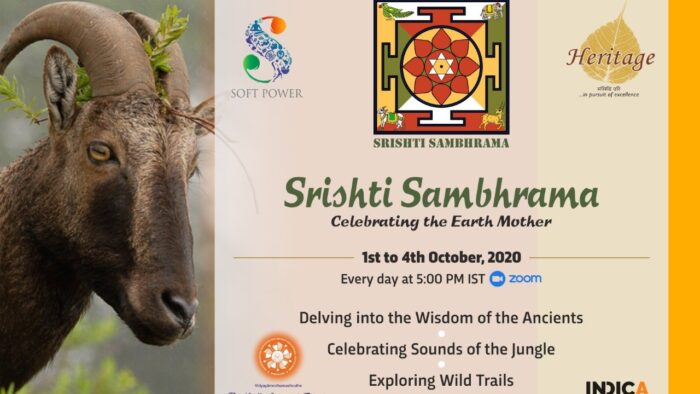The Center for Soft Power in collaboration with Heritage Trust, BNMIT, Wildlife Trust of India and the International Center for Cultural Studies (ICCS) will be organising a virtual global celebration for wild-life week on the 1st, 2nd, 3rd and 4th of October 2020.
The Earth Mother has been worshiped and respected in varying ways in ancient cultures across the globe.The Vedas the largest body of ancient literature that has come down for thousands of years is replete with visions of the beauty of life and nature in rich poetic verses. "Perhaps nowhere else in the world has the glory of dawn and sun-rise and the silence and sweetness of nature, received such rich and at the same time such pure expression," says Dr Shashi Tiwari.
The first environmentalists are often ignored in the light of modern-day crusaders. In truth, they are indigenous people whose beliefs, culture, and practices are visionary and protectionist when it comes to the natural world. "For our people, protecting the environment surpasses the issue of preserving lands, livelihoods, wildlife, and water. There is a spiritual and religious component unique to Indigenous environmentalism since many of our ancestral and traditional practices are tied to the natural world", says one commentator.
The Shristi Sambrahma Celebration seeks to create a circle of conversation around people's identities, culture, community, the earth and the other living beings that inhabit it. "Our ancestors lived in harmony with the land and with what it provides, while staying mindful of the ecological boundaries of the natural world and not taking from the land more than they needed. We see ourselves as being interconnected with all life forms. This awareness and reverence of where we fit into the world guides us. Mother earth does not have a human voice therefore we have the ability to use our voices to call to her needs when she gives us warning and needs our help," says one voice.
Sessions called Lifeline Nurtured will be held on all days. Film maker Kalyan Varma will chair a panel on conservation with Biswajit De, Founder-President, Wild Roots (India), Kaushik Barua, Assam Elephant Foundation (India) and Dr Abhishek Narayanan, Head of Division, Wild Rescue, Wildlife Trust of India (India).
On October 2, we will have a session on Wisdom of the Ancients with Prof Yashwant Pathak, Associate Dean in College of Pharmacy, University of South Florida as Chair and will include Prof Gauri Mahulikar, Dean, Chinmaya Vishwavidyapeeth, Basil Ugorji, Founder and CFO, International Center for Ethno-Religious Mediation (USA) and Elizabeth Aruzuo, Mayan Elder (Guatemala) who will speak about Mayan traditions.
 Brown Winged Kingfisher by Prasad Natarajan
Brown Winged Kingfisher by Prasad Natarajan
October 2 will also see art work of Wildlife artists displayed virtually. Nature’s most vibrant hues are portrayed in large canvases. Artists bring forth scientific ideologies of nature and its conservation practices to life, and in doing so, they form a community that toil diligently towards making this planet a better place to live. Prasad Natarajan, Wildlife Artist, Founder of Artists for Wildlife and Nature (India) will chair a panel including artists from all over the world.
On October 3, James Godber, Photographer, Environmentalist and Diplomat (UK) and Eshwar Maanay, Dean, BNMIT (India) will showcase photographs of 'Everywhere Wild' taken from the most unlikely of places.
October 4th, a film discussion has been curated by wildlife film maker Sugandhi Gadadhar and Danji Thotapalli, Chief Curator & Festival Director, Indica Pictures.
Through a series of discussions, we would like to study how
- How long before modern technology and science, indigenous people (world over) created complex systems to thrive off the land while caring for and maintaining it in turn. How do we bring forward this wisdom to suit the present times?
- How was nature referred to and worshipped through art, music, poetry, mantras, mandalas in ancient India and indigenous cultures across the world. Is it relevant today?
- How did the destabilising of the indigenous cultures change and impact the man-nature connect in different countries. Can we re-establish that connect today? If so how?
- Has rapid modernisation impacted the delicate ecological balance which our ancestors intuitively preserved. Can we look at creating new ways and means of finding balance.
- Shed light on some areas of man-animal relations which are misunderstood or not properly understood, especially with relations to animals considered sacred. How do we educate people to understand that living in harmony with the animal world is in our own interest?
- How can governments bring into focus the plight of animals and make policy changes so planet Earth survives.
The event will bring together, Scholars, indigenous people, environmentalists, naturalists, policy makers, photographers, film makers, artists poets and musicians from several countries. The time to celebrate our reverence for nature has come.




